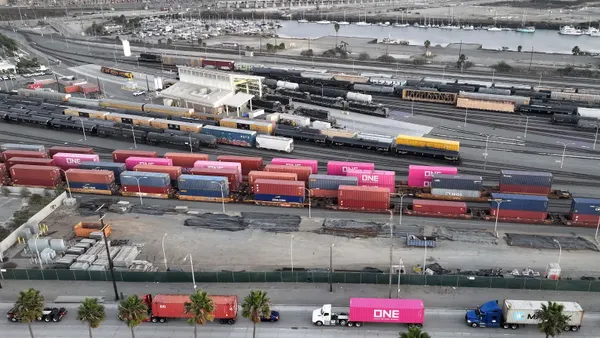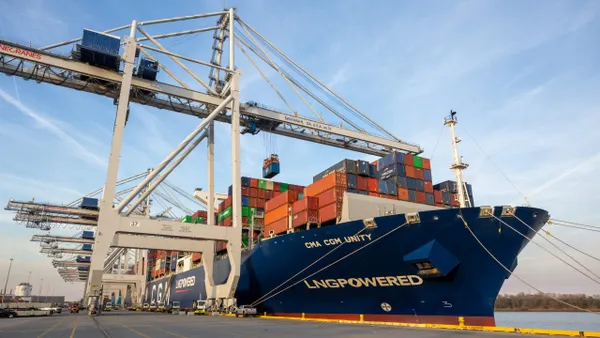Dive Brief:
- A group of 70 organizations consisting of shippers, ocean carriers and energy providers calling itself the Getting to Zero Coalition announced this week it would begin a push to decarbonize the ocean shipping industry in line with Paris Agreement requirements, according to a press release.
- The coalition's goals follow the United Nations International Maritime Organization climate change strategy released in 2018 which says the industry needs to lower the total annual greenhouse gas emissions "by at least 50% by 2050 compared to 2008, while, at the same time, pursuing efforts towards phasing them out entirely."
- It plans to achieve this by integrating commercially viable zero-emission ships into fleets and operating on deep-sea routes by 2030, according to the coalition's announcement.
Dive Insight:
This announcement comes just over three months before IMO's new low-sulfur regulations take effect. On Jan. 1, 2020, ships must comply with a sulfur emissions limit of 0.5% mass by mass, down from the current threshold of 3.5%.
"I am confident that the implementation date on 1 January 2020 will be managed smoothly," IMO Secretary General Kitack Lim said in a speech earlier this month in London.
Lim also touched on the IMO's overall climate goal of halving greenhouse gas (GHG) emissions from their 2008 level by 2050.
"There are already strong signs emerging that some sectors of the industry are really grasping this," he said. "Battery powered and hybrid ferries, ships trialing biofuels or hydrogen fuel cells, wind-assisted propulsion and several other ideas are now being actively explored."
The Getting to Zero Coalition released a four-phase roadmap that outlines how the industry expects to make this happen.
- Phase 1 (2019-2020): Build the coalition by bringing in more members and sharing knowledge.
- Phase 2 (2021-2023): Demonstrate the ability of a ship to safely run on zero-carbon energy sources and the ability to scale the supply of this energy source.
- Phase 3 (2024-2027): Equip trading routes with easy access to zero-carbon energy sources. Expand access to financing and new business models that incentivize moving toward zero-carbon energy sources.
- Phase 4 (2028-2030): Ships powered on zero-carbon energy sources are sailing on "key trade corridors" and the production of this fuel has scaled along with the ships.
Maersk, ONE and ZIM are all listed as coalition members. Large international shippers like Cargill and Unilever have also signed on while energy providers, banks, associations and other organizations round out the coalition.
A.P. Møller Maersk CEO Søren Skou said increased efficiency has helped the carrier to lower carbon dioxide emissions 41% over the last decade, but he said, "efficiency measures can only keep shipping emissions stable, not eliminate them." Maersk is a member of the Getting to Zero Coalition.
"To take the next big step change towards decarbonization of shipping, a shift in propulsion technologies or a shift to clean fuels is required which implies close collaboration from all parties," Skou said. "The coalition launched today is a crucial vehicle to make this collaboration happen."
IMO's most recent estimate of GHG emissions in the shipping industry is from the Third IMO GHG Study released in 2014. This found the ocean shipping industry "emitted 796 million tonnes of CO2 in 2012, which accounts for no more than about 2.2% of the total emission volume for that year." These numbers were even higher before the Great Recession, the study pointed out, reaching 885 million tonnes of CO2 in 2007 or 2.8% of the global emissions of CO2 for that year. (Earlier this year the IMO agreed to begin the process required to update this report for the Fourth IMO GHG Study.)
"Emissions are projected to grow by between 50 and 250% by 2050 if no action is taken," the Getting to Zero Coalition said in its press release this week.














